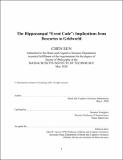The hippocampal "Event Code" : implications from Descartes to Gridworld
Author(s)
Sun, Chen,Ph.D.Massachusetts Institute of Technology. Department of Brain and Cognitive Sciences.
Download1196908062-MIT.pdf (15.53Mb)
Other Contributors
Massachusetts Institute of Technology. Department of Brain and Cognitive Sciences.
Advisor
Susumu Tonegawa.
Terms of use
Metadata
Show full item recordAbstract
The brain codes continuous spatial, temporal, and sensory changes in daily experience. Recent studies suggest the brain also tracks experience as segmented subdivisions (events), but the neural basis for encoding events remains unclear. Here, I present our recent advances to understand the encoding of distinct events at the single cell level. We did preliminary work which revealed distinct neural mechanisms for encoding different spatial contexts. Following this work, we designed a novel maze task for mice which permitted the isolation of neural signals tracking "events" as abstract and discrete entities, separate from sensory changes. This maze task was composed of 4 materially indistinguishable lap events. Using this maze, we reported hippocampal CA1 neurons whose activity was modulated not only by spatial location, but also lap number. These "event-specific rate remapping" (ESR) cells remain lap-specific even when the maze length was unpredictably altered within trials, suggesting ESR cells treated lap events as fundamental units. The activity pattern of ESR cells was reused to represent lap events when the maze geometry was altered from square to circle, suggesting it helped transfer knowledge between experiences. ESR activity was separately manipulable from spatial activity, and may therefore constitute an independent hippocampal code: an "event code" dedicated to organizing experience by events as discrete and transferable units.
Description
Thesis: Ph. D., Massachusetts Institute of Technology, Department of Brain and Cognitive Sciences, May, 2020 Cataloged from PDF version of thesis. Includes bibliographical references (pages 165-183).
Date issued
2020Department
Massachusetts Institute of Technology. Department of Brain and Cognitive SciencesPublisher
Massachusetts Institute of Technology
Keywords
Brain and Cognitive Sciences.